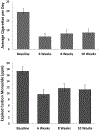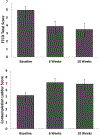Effects of six weeks of electronic cigarette use on smoking rate, CO, cigarette dependence, and motivation to quit smoking: A pilot study
- PMID: 29355819
- PMCID: PMC9885495
- DOI: 10.1016/j.addbeh.2018.01.012
Effects of six weeks of electronic cigarette use on smoking rate, CO, cigarette dependence, and motivation to quit smoking: A pilot study
Abstract
Objectives: Switching from combustible tobacco cigarettes to electronic cigarettes (e-cigs) may or may not help smokers to reduce cigarette consumption and toxicant exposure. This pilot study investigated the effects of asking smokers to switch to e-cigs for 6weeks on smoking, exhaled carbon monoxide (CO) concentration, dependence, and motivation to quit smoking.
Methods: Non-treatment seeking daily smokers (n=18) were given free e-cigs and instructed to use them instead of smoking cigarettes for 6weeks. Smokers were assessed at baseline, weekly for 6weeks, and at 8 and 10weeks for cigarettes/day, e-cig use, CO, cigarette dependence, and Contemplation Ladder.
Results: All participants completed 6weeks; 17 completed 10weeks. At Week 6, cigarettes/day were reduced by two-thirds and CO by 45% from baseline (p's<.001), with reductions maintained at Week 10 (p's<.005). Cigarette dependence scores were a third lower at Weeks 6 (p<.002) and 10 (p<.001) than at baseline. Contemplation Ladder scores were higher at Weeks 6 and 10 (p's<.001) than at baseline. All these statistical effect sizes were large. At Week 6, number of reasons not to use e-cigs increased (p<.011).
Conclusions: Results show preliminary evidence for beneficial effects of short-term switching to e-cigs by non-treatment seeking smokers in terms of reduced smoke toxicant exposure and cigarette dependence, and increased motivation to quit, all maintained at least 4weeks after free e-cigs were no longer provided.
Copyright © 2018 Elsevier Ltd. All rights reserved.
Conflict of interest statement
Conflict of Interest
Dr. Eissenberg is a paid consultant in litigation against the tobacco industry and is named on a patent application for a device that measures the puffing behavior of electronic cigarette users. There are no other interests to declare.
Figures



References
-
- Adriaens K, Van Gucht D, Declerck P, & Baeyens F (2014). Effectiveness of the electronic cigarette: An eight-week Flemish study with six-month follow-up on smoking reduction, craving and experienced benefits and complaints. International Journal of Environmental Research and Public Health, 11, 11220–11248. - PMC - PubMed
-
- Ayers JW, Ribisl KM, & Brownstein JS (2011). Tracking the rise in popularity of electronic nicotine delivery systems (electronic cigarettes) using search query surveillance. American Journal of Preventive Medicine, 40, 448–453. - PubMed
-
- Biener L, & Abrams DB (1991). The contemplation ladder: Validation of a measure of readiness to consider smoking cessation. Health Psychology, 10, 360–365. - PubMed
Publication types
MeSH terms
Substances
Grants and funding
LinkOut - more resources
Full Text Sources
Other Literature Sources
Medical

